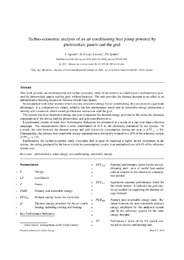Por favor, use este identificador para citar o enlazar este ítem:
https://hdl.handle.net/11000/34221Registro completo de metadatos
| Campo DC | Valor | Lengua/Idioma |
|---|---|---|
| dc.contributor.author | Aguilar, F. | - |
| dc.contributor.author | Crespí Llorens, Damián | - |
| dc.contributor.author | Quiles, P.V. | - |
| dc.contributor.other | Departamentos de la UMH::Ingeniería Mecánica y Energía | es_ES |
| dc.date.accessioned | 2025-01-08T11:43:55Z | - |
| dc.date.available | 2025-01-08T11:43:55Z | - |
| dc.date.created | 2019-01 | - |
| dc.identifier.citation | Solar Energy, 180 (2019) | es_ES |
| dc.identifier.issn | 0038-092X | - |
| dc.identifier.uri | https://hdl.handle.net/11000/34221 | - |
| dc.description.abstract | This work presents an environmental and techno-economic study of an inverter air conditioner simultaneously powered by photovoltaic panels and the grid, without batteries. The unit provides the thermal demand to an office in an administrative building located in Alicante (South East Spain). In comparison with other systems which also use renewable energy for air conditioning, this one presents significant advantages. It is comparatively simple, reliable, has low maintenance needs and its renewable energy production is entirely self-consumed, which avoids problematic interaction with the grid. The system has been monitored during one year to measure the thermal energy provided to the room, the electrical consumption of the device and the photovoltaic and grid contribution to it. Experimental results of some Key Performance Indicators are presented as a result of a one year data collection campaign. The measurements show a solar contribution of 54% to the electricity consumed by the system. As a result, the ratio between the thermal energy and grid electricity consumption during one year is SPFsys = 9.6. Consequently, the primary non–renewable energy consumption is drastically reduced to a 26% of the reference system ( SPF ref = 2.5 ). Furthermore, the techno-economic study concludes that in spite of requiring a higher initial investment in the system, the saving produced by the lower electricity consumption, results in an annualized cost of 84% of the reference system cost | es_ES |
| dc.format | application/pdf | es_ES |
| dc.format.extent | 11 | es_ES |
| dc.language.iso | eng | es_ES |
| dc.publisher | Elsevier | es_ES |
| dc.rights | info:eu-repo/semantics/openAccess | es_ES |
| dc.rights | Attribution-NonCommercial-NoDerivatives 4.0 Internacional | * |
| dc.rights.uri | http://creativecommons.org/licenses/by-nc-nd/4.0/ | * |
| dc.subject | Photovoltaics | es_ES |
| dc.subject | Solar energy | es_ES |
| dc.subject | Air conditioning | es_ES |
| dc.subject | Renewable energy | es_ES |
| dc.subject.other | CDU::6 - Ciencias aplicadas::62 - Ingeniería. Tecnología | es_ES |
| dc.title | Techno-economic analysis of an air conditioning heat pump powered by photovoltaic panels and the grid | es_ES |
| dc.type | info:eu-repo/semantics/article | es_ES |
| dc.relation.publisherversion | https://doi.org/10.1016/j.solener.2019.01.005 | es_ES |

Ver/Abrir:
2019_SE_A_POSTprint.pdf
659,42 kB
Adobe PDF
Compartir:
 La licencia se describe como: Atribución-NonComercial-NoDerivada 4.0 Internacional.
La licencia se describe como: Atribución-NonComercial-NoDerivada 4.0 Internacional.
.png)